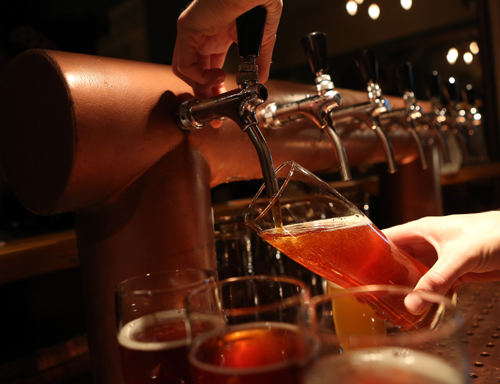Achieving the Perfect Pour
 There is nothing more discouraging for a home brewing enthusiast than carefully pouring a draft of a meticulously brewed and perfected batch of beer, only to discover that the liquid in the glass is an undrinkable, thick, foamy mass of bubbles. A home brewer deserves the exhilaration of a perfectly poured glass of beer, so what is standing in the way of this achievement? What causes even the most sophisticated keg equipment to sputter and choke on excessive foam? How can brewers achieve the perfect pour? The answer, thankfully, is quite simple. If your draft beer system is putting out excessively foamy beer, fixing a few common issues will usually resolve the problem.
There is nothing more discouraging for a home brewing enthusiast than carefully pouring a draft of a meticulously brewed and perfected batch of beer, only to discover that the liquid in the glass is an undrinkable, thick, foamy mass of bubbles. A home brewer deserves the exhilaration of a perfectly poured glass of beer, so what is standing in the way of this achievement? What causes even the most sophisticated keg equipment to sputter and choke on excessive foam? How can brewers achieve the perfect pour? The answer, thankfully, is quite simple. If your draft beer system is putting out excessively foamy beer, fixing a few common issues will usually resolve the problem.
Improving Your Technique
First things first: if your beer is too foamy, you might simply be pouring incorrectly. There is an art to pulling a draft, and even the slightest mistake can alter the finished appearance of your beer. Pull the draft lever toward you in one quick motion. Don't try to adjust the flow by opening the faucet only partially. This creates additional friction in the faucet lines, which aerates the beer, making it foamy.
The position of the glass is also important when pouring a draft beer. The glass should not touch the spigot; instead, position the glass about a quarter of an inch below the spout. Angle the glass at 45 degrees when you begin pouring, as this will allow the beer to flow down the side rather than splash into frothiness at the bottom. As the glass reaches halfway full, begin tilting the glass back to a vertical position. If this solves your problem, congratulations! You're now an expert at pouring draft beer.
Clean and Tidy
The cleanliness and smoothness of your glasses can also affect a beer's head. Rough glasses have excess surface area that encourages carbon dioxide to separate from the beer. Likewise, dirty glasses with water spots, oils, or other impurities can alter the proportion of beer to foam. Always use spotlessly clean, water-rinsed glasses when pouring a draft beer.
Take Your Beer's Temperature
If you're still plagued by extra foam, the odds are good that your draft equipment is experiencing temperature problems. To understand this, we'll have to have a brief chemistry lesson. Liquids possess the chemical ability to absorb dissolved gases. The colder the temperature of the liquid, the more gas it is able to hold in a dissolved state. Consider what happens when you pop open a warm can of beer: foam spews out of the top, and the overall drinking experience is quite poor. If your beer is consistently too foamy when coming out of the faucet, check that the temperature of the liquid in your keg is low enough. You can read more about temperature fixes in our beer line cooling article.
Pressure and Resistance
The pressure inside a beer keg and the amount of resistance present in the beer line can also contribute to foam problems. Higher pressure kegs ensure that more carbon dioxide is dissolved into the beer. Adjusting the pressure of the keg may seem like a simple fix, but changes may need to be made to the length and height of the beer line. The line of tubing that stretches from the keg to the faucet creates resistance, which slows the speed of beer under pressure and results in a more consistent, less foamy pour. Two factors are important in the beer line: the inside diameter of the tubing and the height difference between the keg and the spout. If beer is exiting the faucet too quickly, creating foam, the line may need to be lengthened, the tube diameter decreased, or the height of the faucet increased.
Achieving the perfect pour can be an exercise in trial and error, but adjusting and fixing these common elements will ensure that your beautifully brewed beer comes out of the tap looking and tasting perfect.